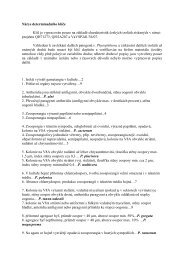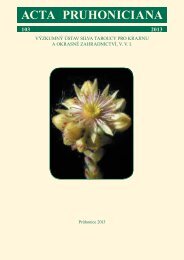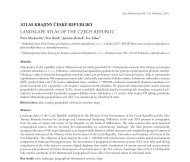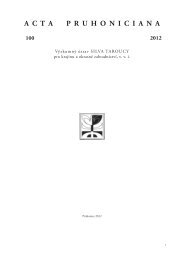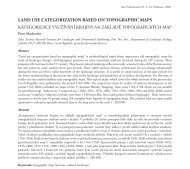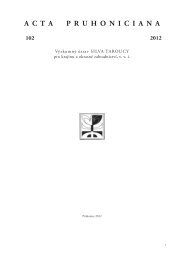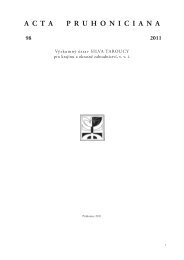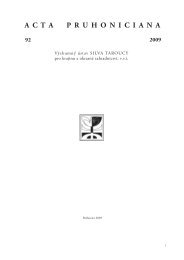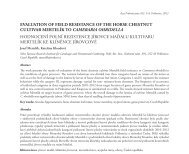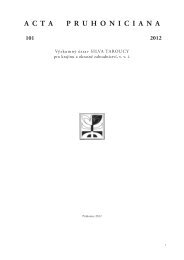Fig. 1 Amygdalus nana L. – individual with fruitAn individual was considered a ramet or a set of ramets(growing from hypocotyl – basal part of ramet) totally orpartially separated from the other ramets and sets of ramets.Individuals were selected randomly (within polycormons) inboth localities, and the selected individuals were labelled (40individuals per locality). In the Vŕšok II. Hill, the A. nanapopulation was scattered to more polycormons, therefore, welabelled the individuals within the fifth polycormons there.The dwarf almond population in the Drieňová hora NatureReserve was more or less continuous (one polycormon).Therefore, we counted the amount of flowers and fruits on theselected individuals there. The fruit set was calculated from thefound A. nana flowers and fruits, as the ratio of the developedgenerative diasporas (fruits) to re<strong>pro</strong>ductive organs (flowers).RESULTS AND DISCUSSIONThe fruit set of A. nana in the year 2007 was relatively low(2.41 %) in the Vŕšok locality and 0.89 % in the Drieňováhora (Table 1, Fig. 5). The mean of flower number in the Vŕšokwas higher (72.14) than in the Drieňová hora (23.33). Onthe selected ramets, fruit <strong>pro</strong>duction was very low. While 21fruits were found in the Vŕšok II. hill (16 degenerated), onlyFig. 2 Amygdalus nana L. – flowering individual5 fruits were developed to mature stage in the Drieňová horaNature Reserve. However, all these fruits were degenerated.As it has been mentioned above, the genus Amygdalus isself-sterile, that means that fruit <strong>pro</strong>duction is rare, even incase of the ones not developed completely (they finish withdeveloping in a certain phase, and dry later). In the year 2008the fruit set of A. nana increased in both localities – it reached8.06 % in the Vŕšok, and 7.28 % in the Drieňová hora (Table1, Fig. 6). It was <strong>pro</strong>bably caused by more favourable climaticconditions. Different ecological conditions could have beena possible source of fruit set value variability at the selectedhabitats.Similarly, Krchňavá et al. (2003) report a very low fruit setfrom the Vŕšok locality (only 0.7 %), with the fruit set valuecalculated from normally developed fruits. Also other authorsindicate low fruit set in similar species. In C. fruticosa, Ághová(2000) found a relatively low fruit set on the Pyramída hilllocality (the Tríbeč Mts.) during vegetation seasons 1997–1999 (fruit set was 0.94 to 2.87 %). The fruit set decreasedwith increasing rainfall during flowering and with increasingtemperature. Guitián et al. (1992) studied fruit set of Prunusspinosa, P. mahaleb and Crataegus monogyna in north-westernIberian Penninsula. They found a very low fruit set in thementioned species (
Table 1 Characteristics of generative re<strong>pro</strong>duction of two A. nana populations: in the Vŕšok II. hill and in the Drieňová hora NatureReserve in years 2007–2008Number of flowers Number of fruits FS [%]Year Ø Min Max ∑ Ø Min Max ∑ DPV 2007 72.14 0 214 873 0.57 0 4 21 16 2.412008 26.16 1 151 968 2.11 0 15 78 70 8.06DH 2007 23.33 4 56 560 0.21 0 3 5 5 0.892008 42.68 2 127 1579 3.11 0 14 115 114 7.28V – the Vŕšok II. hill, DH – the Drieňová hora hill, Ø – average, ∑ – sum, DP – degenerated fruits, FS – fruit set: (number of flowers/number of fruits) × 100103Fruit set values [%]86428.06 7.28Fruit set values [%]2,521,510,50.892.410the Všok II. hillthe Drieová hora hill0the Všok II. hillthe Drieová hora hillFig. 5 A. nana fruit set in the Vŕšok II. hill and in the Drieňováhora in 2007Fig. 6 A. nana fruit set in the Vŕšok II. hill and in the Drieňováhora in 2008spinosa, while in case of P. mahaleb, it occurred duringflowering. Baranec (1996) studied re<strong>pro</strong>ductive biology offour endangered species (Rosa pimpinellifolia, R. gallica, R.arvensis and Cerasus fruticosa) during years 1992 and 1995in the Tríbeč Mts. He ascertained the lowest fruit set in R.pimpinellifolia – only 6.3 % and C. fruticosa – 2.1 %. Nofruits were developed in some years. On the other hand, thehighest fruit set (43.7 %) was found in Rosa gallica.Ďurišová et al. (2007) observed a similar variability ofVaccinium uliginosum fruit set in the Klin locality, where itreached maximum (61.76 %) in 1998 and minimum (24.88%) in 1999. According to Eliáš (2004), increasing rainfallnegatively influenced generative re<strong>pro</strong>duction success ofVaccinium uliginosum in the flowering season. On the contrary,higher temperature sum enhanced <strong>pro</strong>bability of fruit set andthe related activity of pollinators – it contributed to successin generative re<strong>pro</strong>duction under optimal microclimaticconditions.CONCLUSIONSAccording to comparative analyses performed in 2007–2008,we found that both studied local populations of the dwarfalmond (A. nana L.) showed the disparity between the flowersand fruits <strong>pro</strong>duction. Relatively low and variable fruit set wasdependent on climatic conditions. Localisation of habitats, aswell as related ecological conditions can be some reasons offruit set value variability.AcknowledgementWe are thankful to J. Karšňáková and M. Rakovská for helpin field work. This work was supported by the <strong>pro</strong>jects ofMinistry of Education VEGA No. 1/0672/08 and 1/0814/09.REFERENCESÁghová, K. (2000): Re<strong>pro</strong>dukčná biológia r. Cerasus fruticosa.Diplomová práca, SPU Nitra, 62 s.Bertová, L. (1992): Amygdalus L. mandľa. In Bertová, L. et al.Flóra Slovenska IV/3. Bratislava, Veda, s. 492–494, ISBN80-224-0077-7.Bogyová, M. (1982): Chránené územia okolia Štúrova.Diplomová práca, VŠP Nitra, 50 s.Baranec, T. (1995): Biodiverzita niektorých zástupcov čeľadeRosaceae L. na Slovensku. In Ochrana biodiverzity rastlín,zborník referátov z vedeckej konferencie, VŠP Nitra,s. 39–40, ISBN 80-7137-231-5.Baranec, T. (1996): Monitoring re<strong>pro</strong>dukčného <strong>pro</strong>cesuniektorých ohrozených druhov drevín čeľade Rosaceae L.v Tríbči. Rosalia, roč. 11, s. 55–64.Baranec, T. [ed.] (1997): Experimentálne štúdium biológieohrozených druhov rastlín z aspektu ochrany ichgenofondu. Záverečná správa <strong>pro</strong>jektu VEGA č. 1131/94,VŠP Nitra, 66 s.Baranec, T., Poláčiková, M., Košťál, J. (1998): Systematickábotanika. SPU Nitra, 206 s., ISBN 80-967111-2-1.61
- Page 1 and 2:
A C T AP R U H O N I C I A N A93 20
- Page 3:
OBSAHVliv různých forem železa a
- Page 6 and 7:
(Fe-EDDHA) je z dostupných slouče
- Page 8 and 9:
Tab. 3 Chemické vlastnosti substr
- Page 11 and 12: Acta Pruhoniciana 93: 11-14, Průho
- Page 13 and 14: (obr. 3), nebo úzké, protáhlé s
- Page 15 and 16: Acta Pruhoniciana 93: 15-18, Průho
- Page 17 and 18: Pro inokulaci byly použity rostlin
- Page 19 and 20: Acta Pruhoniciana 93: 19-26, Průho
- Page 21 and 22: quite easily. In addition, seedling
- Page 23 and 24: Table 5 Segregation of leaf colour
- Page 25 and 26: Table 7 Percent relative vitality o
- Page 27 and 28: Acta Pruhoniciana 93: 27-30, Průho
- Page 29 and 30: Tab. 1 Rozsah sbírek a možnosti v
- Page 31 and 32: Acta Pruhoniciana 93: 31-35, Průho
- Page 33 and 34: Tab. 2 Vliv koncentrace NAA a cytok
- Page 35: Mitra, G. C. (1989): Biology, conse
- Page 38 and 39: poznatky o našich endemických je
- Page 40 and 41: Sorbus eximia - jeřáb krasovýSor
- Page 42 and 43: lze nalézt habituálně nejlépe v
- Page 44 and 45: 10 Čepel listů okrouhle vejčitá
- Page 46 and 47: Základní taxonomické studium rod
- Page 48 and 49: ný v našich přírodních populac
- Page 50 and 51: ZÁVĚRYPinus neilreichiana je v l
- Page 52 and 53: spěvku je osvětlit ožehavou a v
- Page 54 and 55: cekmenné stromky rozvětvené od z
- Page 56 and 57: začal buk plodit, první silnějš
- Page 59: Acta Pruhoniciana 93: 59-62, Průho
- Page 63 and 64: Acta Pruhoniciana 93: 63-67, Průho
- Page 65 and 66: nezřídka zaměňovány, přitom n
- Page 67: MSI (2001): Checklist of Magnolia C
- Page 70 and 71: in Eastern Slovakia, on the border
- Page 72 and 73: Table 2. Some genetic diversity par
- Page 74 and 75: heterozygosity of 0.269. Also, Konn
- Page 77 and 78: Acta Pruhoniciana 93: 77-82, Průho
- Page 79 and 80: pólové jadrá. Davis (1966) uvád
- Page 81 and 82: Obr. 17 P. spinosa (21. 4. 2009) -
- Page 83 and 84: Acta Pruhoniciana 93: 83-88, Průho
- Page 85 and 86: Na počátku pokusu měly všechny
- Page 87 and 88: Tab. 9 Doronicum orientale ‘Leona
- Page 89 and 90: Acta Pruhoniciana 93: 89-95, Průho
- Page 91 and 92: Popis stanovištěDendrologická za
- Page 93 and 94: Oenothera glazioviana O. erythrosep
- Page 95: preference. Landscape and Urban Pla
- Page 98 and 99: Tab. 1 Původ uloženého osivaDár
- Page 100 and 101: Kapacita regeneračního procesu p
- Page 102 and 103: u nás pěstují, prodávávají ne
- Page 104 and 105: 104Odrůda Šlechtitel Rok Skupina
- Page 106 and 107: 106Odrůda Šlechtitel Rok Skupina
- Page 108 and 109: Výběr odrůd s uvedením cenných
- Page 110 and 111:
110
- Page 112 and 113:
Vědecký název Český název Če
- Page 114 and 115:
Hottonia palustris L. - žebratka b
- Page 116 and 117:
palustris Gaud. na Moravě. Diplomo
- Page 118 and 119:
na přírodním stanovišti. Uplatn
- Page 120 and 121:
také J. Holzbecher, J. Janouš a V
- Page 122 and 123:
Kultivar Hybridní skupina Původ B
- Page 124 and 125:
Kultivar Hybridní skupina Původ B
- Page 126 and 127:
Kultivar Hybridní skupina Původ B
- Page 128:
Horný, R., Soják, J., Webr, K. M.




